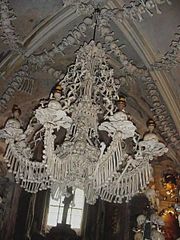Sedletz ossuary
The Sedletz Ossuary (Czech: Kostnice Sedlec ) is an ossuary in Sedletz (Czech: Sedlec), a district of Kutná Hora , about 70 km east of Prague. It is located in the basement of the All Saints Church (Czech: Hřbitovní kostel Všech svatých ) on the Sedletz cemetery. The church and ossuary gained fame for the storage of around 40,000 human skeletons, of which the bones of around 10,000 people were artistically processed to form decorations and furnishings for the church building.
background
Monastery cemetery
According to legend, Henry, abbot of was Cistercian - monastery Sedletz , in 1278 by King Ottokar Premysl II. Sent from Bohemia with a message to Jerusalem. On his return trip, the abbot brought a handful of earth from Calvary and distributed it over the monastery cemetery, which was declared holy ground.
As a result, the cemetery developed into a coveted burial site in Central Europe, where not only people from the area around Sedletz and Bohemia, but also from Poland, Bavaria and the Netherlands were buried. Due to the plague epidemics in the middle of the 14th century ( which caused the cemetery to count around 30,000 dead) and the Hussite Wars in the 15th century, which claimed several thousand victims, the cemetery had to be constantly expanded. The area experienced its greatest expansion with approximately 3.5 hectares. Many of the dead were buried in mass graves.
Construction of the church building
In the early 15th century, a two-story church building in the Gothic style was built in the center of the cemetery. During the construction work, the remains of the dead were exhumed and stored in the basement of the church building, which has since been used as an ossuary. As the cemetery was to be reduced in size, the exhumation of the dead continued after the church was built. According to tradition, this order was carried out from around 1511 by a half-blind Cistercian monk who systematically laid the bones in the ossuary. In total, the remains of around 40,000 people were brought together.
Between 1703 and 1710 Johann Blasius Santini-Aichl rebuilt the entrance area and part of the upper floor of the church in the Bohemian late baroque style . After the Josephine reforms , the Schwarzenberg family became aware of the church building and bought it in the 19th century. In 1870 she commissioned the wood carver František Rint from Skalitz to furnish the ossuary's interior in a rather unusual way: Rint did not use wood as the building material, but the bones stored in the ossuary.
Interior
František Rint created the entire inventory with the help of human bones. For this he needed the bones of around 10,000 people. Not far from the entrance door, a staircase leads to the basement of the church building. On both sides of the staircase there are two almost human-sized goblets . To the right, next to one of the chalices, there is a Jesus monogram made of bones and skulls .
In the middle of the room in the basement there is an eight-armed chandelier that contains almost all types of bones in the human body. Below the chandelier there are four pinnacles , each equipped with 22 skulls. The vault was decorated with several garlands of skulls and humerus bones; Similar constructs can be found as wall decorations and especially on the belt arches .
On the left side of the room hangs the coat of arms of the Schwarzenberg family, also made entirely of bones. Among other things, it shows a raven who - symbolically and based on the battles with the Ottomans in the 16th century - hacking out the left eye of a skull (in this case a fighter who fell on the battlefield).
Most of the bones, however, were conically piled up in the adjoining rooms, and a total of four gigantic mountains of bones adorn the aisles of the basement . In the niches to the left and right of the main altar are two monstrances . On some skulls, especially those lying near the side altars, clear traces of the fighting during the Hussite Wars can be seen ( flail , hammer).
Rint himself left his name - sculpted out of bones - on a wall next to the staircase.
- Interior
Media reception
In 1970, a century after František Rint's work was completed, the Czech artist and film director Jan Švankmajer was commissioned to produce a documentary on the ossuary. The end result includes a 10-minute black and white production under the title "Kostnice" (English film title "The Ossuary"), with a high cut frequency, accompanied by separately recorded explanations by a tour guide.
Švankmajer later modified the documentation and replaced the narrator's voice with a short linguistic introduction and a jazz instrumental by the Czech musician Zdeněk Liška , which he originally dedicated to the poem "Comment dessiner le portrait d'un oiseau" by Jacques Prévert .
After the turn of the millennium, the ossuary attracted increasing interest from the film industry. Among other things, it served as the backdrop for the fantasy adventure Dungeons & Dragons (2000) and was featured in the documentary film series Long Way Round four years later .
The 83rd version of the book or the 116th series of radio plays in the TKKG series with the title “Klassenfahrt zur Hexenburg” takes up the history of the Sedletz ossuary in the form of the “Hexenburg”.
Web links
- Official website (cz, en)
- Bohemian Bone Church - report by Spiegel Online
Coordinates: 49 ° 57 ′ 43 ″ N , 15 ° 17 ′ 18 ″ E








